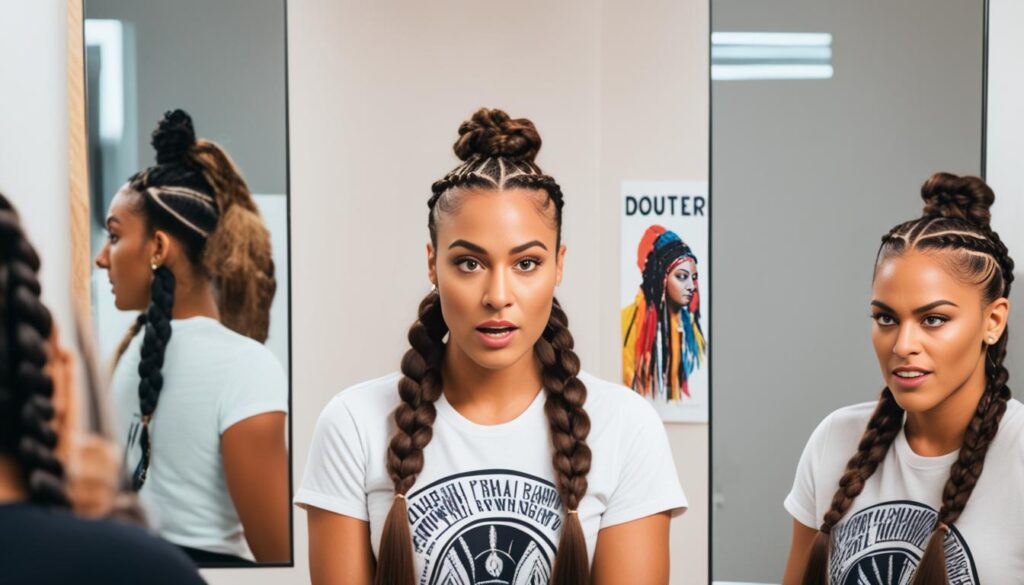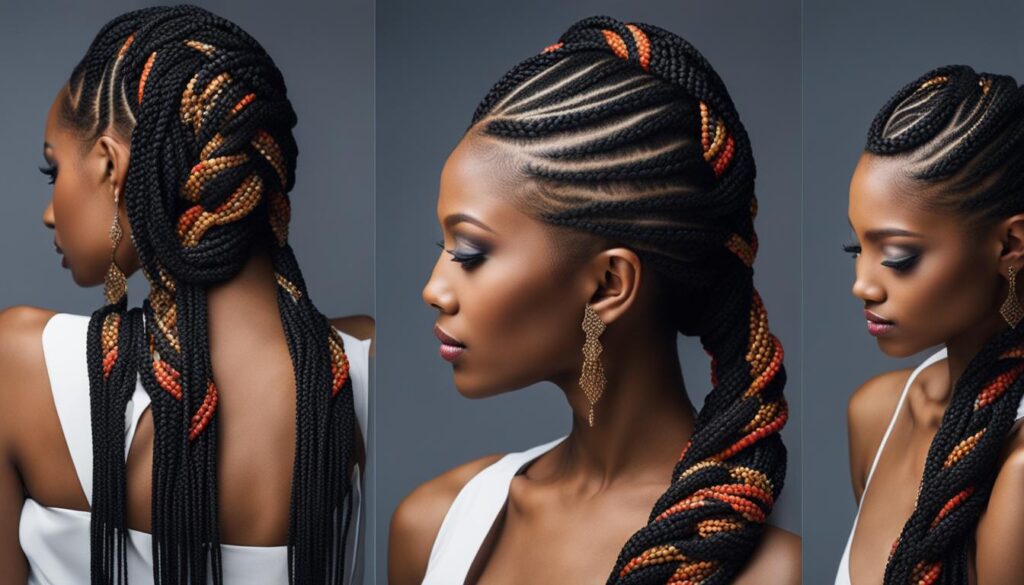
When you think of French braids, what comes to mind? Elegance, sophistication, and perhaps a touch of French culture. But did you know that the history of French braids goes beyond France? In fact, French braids have deep roots in African culture and heritage, shaping their significance and appeal. So, are French braids truly African in origin? Let’s delve into the cultural roots and history of French braids to uncover the fascinating connection between this iconic hairstyle and the African continent.
Key Takeaways:
- French braids have a long and rich history intertwined with African culture.
- While French braids are not specifically African in origin, they have deep roots in the African continent.
- African tribes have been braiding their hair for thousands of years, using braided hairstyles to identify tribes and express cultural heritage.
- The history of French braids is shrouded in mystery, with no definitive origin story.
- French braids have been influenced by various cultures throughout history, including African, Greek, and Chinese.
The History of French Braids
The history of French braids is fascinating and filled with cultural influences from various parts of the world. While there is no definitive origin story, three cultures are considered possible originators of French braids: North Africa, Greece, and China.
In North Africa, rock art in the mountain range of Tassili n’Ajjer in Algeria showcases women with rowed braids, suggesting that braided hairstyles were prevalent in this region. This indicates that the roots of French braids may lie in African braiding traditions.
Furthermore, Greek history also offers evidence of braided hairstyles. The Kouros statue, believed to have originated in ancient Greece, depicts a man with braided hair. This demonstrates that braiding techniques were in experimentation in Greece during those times.
There are also theories that speculate the women of the Song Dynasty in China as potential pioneers of French braids. Although not widely accepted, this speculation highlights the global influence and evolution of braided hairstyles.
While the exact origins of French braids remain uncertain, it is clear that these hairstyles have evolved through the interplay of various cultures throughout history.
“The history of French braids is a diverse tapestry woven by the hands of different cultures.”
Evolution of French Braids
French braids have undergone an evolutionary journey, adapting and transforming over time. From their probable African roots to their incorporation into diverse cultural practices, French braids have gained significant cultural significance.
Over centuries, French braids have evolved from simple styles to intricate and elaborate designs. They have become not only a practical way to manage and protect hair but also a statement of fashion and personal expression. French braids can be admired for their versatility, as they can be styled for casual everyday wear or for special occasions.
Cultural Significance of French Braids
The cultural significance of French braids is far-reaching and reflects the multicultural tapestry of our world. From their African origins to their influences from Greece and China, French braids represent the beauty of cultural exchange and shared heritage.
French braids not only showcase the diversity and creativity of different communities but also serve as a symbol of cultural pride and identity. They embody the artistry and skill of braiding techniques passed down through generations, carrying rich cultural traditions forward.
Related:Cultural sensitivity in hairstyles
It is crucial to approach French braids and other braided hairstyles with cultural sensitivity and respect. Recognizing and understanding the cultural significance of these hairstyles is essential to avoid cultural appropriation and foster inclusivity.
By appreciating the history and significance of French braids, we can celebrate their beauty while promoting cultural understanding and respect.
| Origin | Cultural influences | Key Features |
|---|---|---|
| North Africa | Deep African braiding traditions | Rowed braids |
| Greece | Greek experimentation with braiding techniques | Braided hairstyles depicted in ancient art |
| China | Speculated influence from the Song Dynasty | Possible early adoption of French braids |
Why is it Called French Braid?
Despite its name, French braids do not actually have a direct connection to France or French culture. The term “French braid” originated from a short story published in Arthur’s Home Magazine in 1871, in which a husband references a “new French braid” hairstyle. This association with France and the notion of elegance and sophistication led to the name sticking. It is important to note that the style itself is not exclusive to French culture, and its origins can be traced back to various other cultures, as mentioned earlier.
| Francois | Frederique | Francoise |
|---|---|---|
| French Braid History | French Braid Techniques | French Braid Misconceptions |
| 1871: Arthur’s Home Magazine mentions “new French braids” | Greek, African, and Chinese influences | Not exclusive to French culture |
| No direct connection to France or French culture | Complex and intricate designs | Associated with elegance and sophistication |
Braids and Cultural Appropriation
Cultural appropriation is a complex and controversial issue when it comes to braided hairstyles. While French braids themselves are not considered culturally appropriative, other styles, such as cornrows, have faced criticism for being appropriated by non-black individuals without a proper understanding or respect for their cultural significance.
Cornrows have deep roots in African culture and hold historical importance to the identity of African people. They are more than just a hairstyle; they are a form of self-expression, and specific cornrow designs can convey information about a person’s background and social status. Unfortunately, when these styles are taken out of their cultural context and worn by individuals who do not share these experiences, it can diminish their cultural significance and perpetuate stereotypes.
“Cornrows have deep roots in African culture and hold historical importance to the identity of African people.”
Cultural sensitivity is crucial when it comes to engaging with hairstyles that have cultural significance. It is essential to acknowledge and respect the roots of these styles and understand the historical and social context from which they emerged. Appreciating the beauty and artistry of braided hairstyles should go hand-in-hand with an understanding of their cultural heritage and respect for those who originated and continue to embrace these styles.
The Importance of Cultural Sensitivity
Cultural sensitivity in hairstyles means recognizing and appreciating the cultural significance and history behind different braided styles. It involves understanding the context in which these styles developed and avoiding their appropriation for fashion or trend purposes without giving credit to their origins.
By embracing cultural sensitivity, you can show respect for the traditions and heritage associated with braided hairstyles. This involves engaging with these styles in ways that are considerate, educational, and inclusive. It means celebrating the beauty and diversity of braids while acknowledging and honoring the communities from which they originated.
Cultural sensitivity also extends to creating spaces of inclusivity and amplifying the voices of those directly connected to these hairstyles. It means supporting and uplifting black hairstylists, salons, and communities, rather than diluting and appropriating their cultural practices for personal gain or trend-chasing.
Cultural Appreciation vs. Cultural Appropriation
| Cultural Appreciation | Cultural Appropriation |
|---|---|
| Learning about the cultural significance and history of braided hairstyles | Wearing braided hairstyles without understanding or respecting their cultural roots |
| Supporting and acknowledging the communities from which braided hairstyles originated | Taking credit for or profiting from braided hairstyles without crediting or supporting the communities |
| Engaging with braided hairstyles in an educational and respectful manner | Using braided hairstyles simply as a trendy fashion statement without recognizing their cultural significance |
It is important to approach braided hairstyles with cultural sensitivity, recognizing that these styles are more than just a fashion trend. They carry deep cultural roots and hold significant meaning to the communities that originated them. By understanding, appreciating, and respecting the history and culture behind braids, we can celebrate their beauty while promoting inclusivity and understanding.

The Contemporary Art of Braiding
Braids have evolved over time to become more than just hairstyles. They have transformed into a dynamic art form that allows for artistic expression and serves as a medium for creativity. From traditional three-strand braids to complex and intricate designs, braids have truly evolved into a form of artistic expression.
Modern braiding techniques have expanded the possibilities of braided hairstyles. Braids can now be embellished with beads, shells, and colorful extensions, adding a unique and personal touch to each style. These embellishments provide opportunities for self-expression and allow individuals to showcase their artistic vision.
The artistry of braided hairstyles is evident in the diverse trends that have emerged. From box braids to fishtail braids, individuals are constantly pushing the boundaries and experimenting with new styles. There is a braided hairstyle for every occasion, whether it’s a formal event or a casual everyday look.
Braids have become increasingly popular across different cultures and communities, showcasing their versatility and universal appeal. People of all backgrounds are embracing braids as a way to express their style and embrace their heritage. It’s a testament to the power of braided hairstyles that they can be adapted and embraced by individuals from diverse cultural backgrounds.
The evolution of braids into an art form has allowed for artistic expression and personal creativity. Through braids, individuals can showcase their unique style and tell a story. The versatility of braids allows for endless possibilities, making them an ideal choice for those looking to express themselves through their hair.

Artistic expression through braids is a celebration of individuality and cultural heritage. Whether it’s a simple braid or an intricate design, each hairstyle reflects the creativity and personal style of the person wearing it. Braids have become a powerful tool for self-expression, allowing individuals to embrace their roots and showcase their unique identity.
Conclusion
French braids have a complex and diverse history that intersects with African culture. Although not directly originating from Africa, French braids have been heavily influenced by African braiding traditions, making them an important part of African heritage. These braids have evolved to become a widely recognized and appreciated hairstyle in various communities around the world.
Understanding the cultural significance of braided hairstyles is crucial. Braids have served as more than just a fashion statement in African tribes; they were a way to identify the tribe, convey social status, and express cultural heritage. It is important to approach braids with respect and cultural sensitivity, appreciating their roots and the significance they hold.
Furthermore, the issue of cultural appropriation in braided hairstyles, particularly with styles like cornrows, has sparked important discussions. As these styles have deep roots in African culture, it is essential to recognize and appreciate their origins. Cultural sensitivity and education are vital in ensuring that these hairstyles are celebrated in the right way, avoiding misappropriation and respecting the cultures from which they originate.
By acknowledging the history and cultural significance of braids, we can celebrate their beauty and diversity while promoting inclusivity and cultural understanding. French braids serve as a testament to the cross-cultural influences that have shaped hairstyles throughout history, and they continue to be an artistic expression and a symbol of heritage for many people today.






